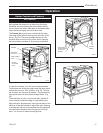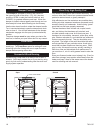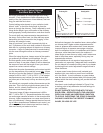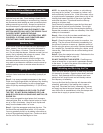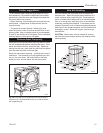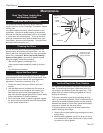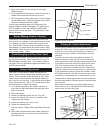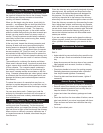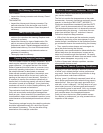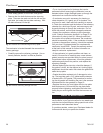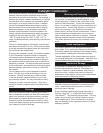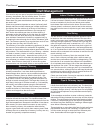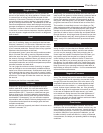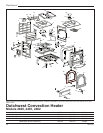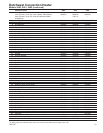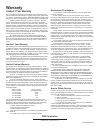
25
Dutchwest
7001135
The Chimney Connector
TWO WEEKS:
• Inspect the chimney connector and chimney. Clean if
necessary.
TWO MONTHS:
• Inspect the chimney and chimney connector. Pay
particular attention to the horizontal runs of chim-
ney connector, and the elbows. Clean the system if
necessary.
Yearly Spring Cleaning
• Disassemble the chimney connector and take it
outdoors for inspection and cleaning. Replace weak
sections of connector.
• Inspect the chimney for signs of deterioration. Re-
pairs to a masonry chimney should be made by a
professional mason. Replace damaged sections of
prefabricated chimney. Your local Dutchwest dealer
or a chimney sweep can help determine when re-
placement is necessary.
• Thoroughly clean the chimney.
Care of the Catalytic Combustor
This wood heater contains a catalytic combustor, which
needs regular inspection and periodic replacement for
proper operation. It is against the law in the United
States to operate this wood heater in a manner incon-
sistent with operating instructions in this manual, or if
the catalytic element is deactivated or removed.
Under normal operating conditions, the catalytic com-
bustor should remain active for two to six years (de-
pending on the amount of wood burned). However, it
is important to monitor the combustor periodically to
ensure that it is functioning properly, as well as to deter-
mine when it needs to be replaced. A non-functioning
combustor will result in a loss of heating efficiency, and
an increase in creosote and emissions.
The combustor should be visually inspected “in place”
for fly ash accumulation and physical damage three
times per year. Actual removal of the combustor is not
recommended unless a more detailed inspection is war-
ranted because of diminished performance as outlined
below.
The refractory package housing the catalytic combustor
should be inspected annually for a build-up of fly ash
and cleaned if necessary. This may be done during
examination of the catalytic combustor.
When to Suspect A Combustor Problem
There are two ways to evaluate the performance of
your stove’s combustor.
The first is to monitor the temperatures on the probe
thermometer. A properly-functioning combustor should
operate in the range of 800-1200
0
F. (430-650°C.).
Combustor temperatures consistently less than 800
0
F.
(430°C.) merit a closer examination of the combustor.
The second performance test is to observe the amount
of smoke leaving the chimney — both when the com-
bustor has achieved “light-off” and when it has not.
Follow this simple two-step procedure:
• With a fire in the stove and the combustor properly
activated by the closing of the stove damper to route
smoke through it as described in the Operation Section,
go outside and observe the smoke leaving the chimney.
• Then, open the stove damper and once again ob-
serve the smoke leaving the chimney.
Significantly more smoke should be observed after the
second step when the stove damper is open and ex-
haust is not routed through the combustor. Be careful
not to confuse smoke with steam from wet wood. Unlike
smoke, steam disappears very quickly in air.
If either of these tests indicates a problem, consider
other possible factors as well.
Assess Your Present Operating Conditions
In Spring or Fall, draft strength is less than in the middle
of winter, and a related change in stove performance
may result. Small hot fires are a good solution to slug-
gish performance under these conditions.
Burning “green” (insufficiently seasoned) wood will re
-
sult in poorer performance than when burning properly
seasoned fuel. Was your fuel supply good and dry to
start with, or has it changed? You may have to run your
stove hotter (more air) to achieve good performance if
you are burning green or wet wood. Also, any changes
in operating routine should be considered at this time
as a possible reason for changed performance.
Once you have ruled out any other possible causes
for a decline in performance, you may proceed with an
inspection of the catalyst.



